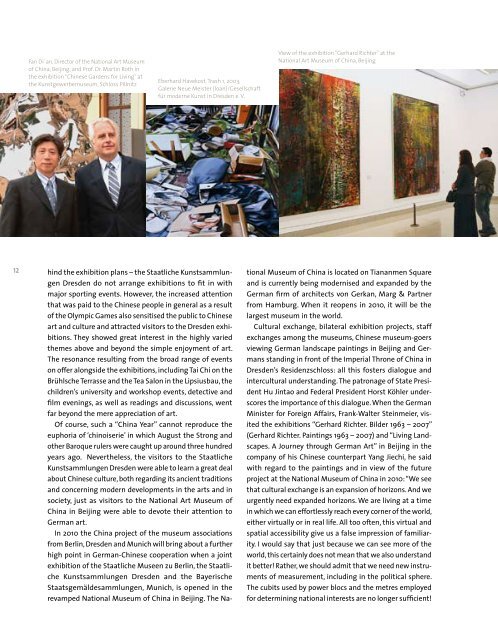2008 - Staatliche Kunstsammlungen Dresden
2008 - Staatliche Kunstsammlungen Dresden
2008 - Staatliche Kunstsammlungen Dresden
Create successful ePaper yourself
Turn your PDF publications into a flip-book with our unique Google optimized e-Paper software.
Fan Di´an, Director of the National Art Museum<br />
of China, Beijing, and Prof. Dr. Martin Roth in<br />
the exhibition “Chinese Gardens for Living” at<br />
the Kunstgewerbemuseum, Schloss Pillnitz<br />
Eberhard Havekost, Trash 1, 2003,<br />
Galerie Neue Meister (loan)/Gesellschaft<br />
für moderne Kunst in <strong>Dresden</strong> e. V.<br />
12 hind the exhibition plans – the <strong>Staatliche</strong> <strong>Kunstsammlungen</strong><br />
<strong>Dresden</strong> do not arrange exhibitions to fit in with<br />
major sporting events. However, the increased attention<br />
that was paid to the Chinese people in general as a result<br />
of the Olympic Games also sensitised the public to Chinese<br />
art and culture and attracted visitors to the <strong>Dresden</strong> exhibitions.<br />
They showed great interest in the highly varied<br />
themes above and beyond the simple enjoyment of art.<br />
The resonance resulting from the broad range of events<br />
on offer alongside the exhibitions, including Tai Chi on the<br />
Brühlsche Terrasse and the Tea Salon in the Lipsiusbau, the<br />
children’s university and workshop events, detective and<br />
film evenings, as well as readings and discussions, went<br />
far beyond the mere appreciation of art.<br />
Of course, such a “China Year” cannot reproduce the<br />
euphoria of ‘chinoiserie’ in which August the Strong and<br />
other Baroque rulers were caught up around three hundred<br />
years ago. Nevertheless, the visitors to the <strong>Staatliche</strong><br />
<strong>Kunstsammlungen</strong> <strong>Dresden</strong> were able to learn a great deal<br />
about Chinese culture, both regarding its ancient traditions<br />
and concerning modern developments in the arts and in<br />
society, just as visitors to the National Art Museum of<br />
China in Beijing were able to devote their attention to<br />
German art.<br />
In 2010 the China project of the museum associations<br />
from Berlin, <strong>Dresden</strong> and Munich will bring about a further<br />
high point in German-Chinese cooperation when a joint<br />
exhibition of the <strong>Staatliche</strong> Museen zu Berlin, the <strong>Staatliche</strong><br />
<strong>Kunstsammlungen</strong> <strong>Dresden</strong> and the Bayerische<br />
Staatsgemäldesammlungen, Munich, is opened in the<br />
revamped National Museum of China in Beijing. The Na-<br />
View of the exhibition “Gerhard Richter” at the<br />
National Art Museum of China, Beijing<br />
tional Museum of China is located on Tiananmen Square<br />
and is currently being modernised and expanded by the<br />
German firm of architects von Gerkan, Marg & Partner<br />
from Hamburg. When it reopens in 2010, it will be the<br />
largest museum in the world.<br />
Cultural exchange, bilateral exhibition projects, staff<br />
exchanges among the museums, Chinese museum-goers<br />
viewing German landscape paintings in Beijing and Germans<br />
standing in front of the Imperial Throne of China in<br />
<strong>Dresden</strong>’s Residenzschloss: all this fosters dialogue and<br />
intercultural understanding. The patronage of State President<br />
Hu Jintao and Federal President Horst Köhler underscores<br />
the importance of this dialogue. When the German<br />
Minister for Foreign Affairs, Frank-Walter Steinmeier, visited<br />
the exhibitions “Gerhard Richter. Bilder 1963 – 2007”<br />
(Gerhard Richter. Paintings 1963 – 2007) and “Living Landscapes.<br />
A Journey through German Art” in Beijing in the<br />
company of his Chinese counterpart Yang Jiechi, he said<br />
with regard to the paintings and in view of the future<br />
project at the National Museum of China in 2010: “We see<br />
that cultural exchange is an expansion of horizons. And we<br />
urgently need expanded horizons. We are living at a time<br />
in which we can effortlessly reach every corner of the world,<br />
either virtually or in real life. All too often, this virtual and<br />
spatial accessibility give us a false impression of familiarity.<br />
I would say that just because we can see more of the<br />
world, this certainly does not mean that we also understand<br />
it better! Rather, we should admit that we need new instruments<br />
of measurement, including in the political sphere.<br />
The cubits used by power blocs and the metres employed<br />
for determining national interests are no longer sufficient!

















